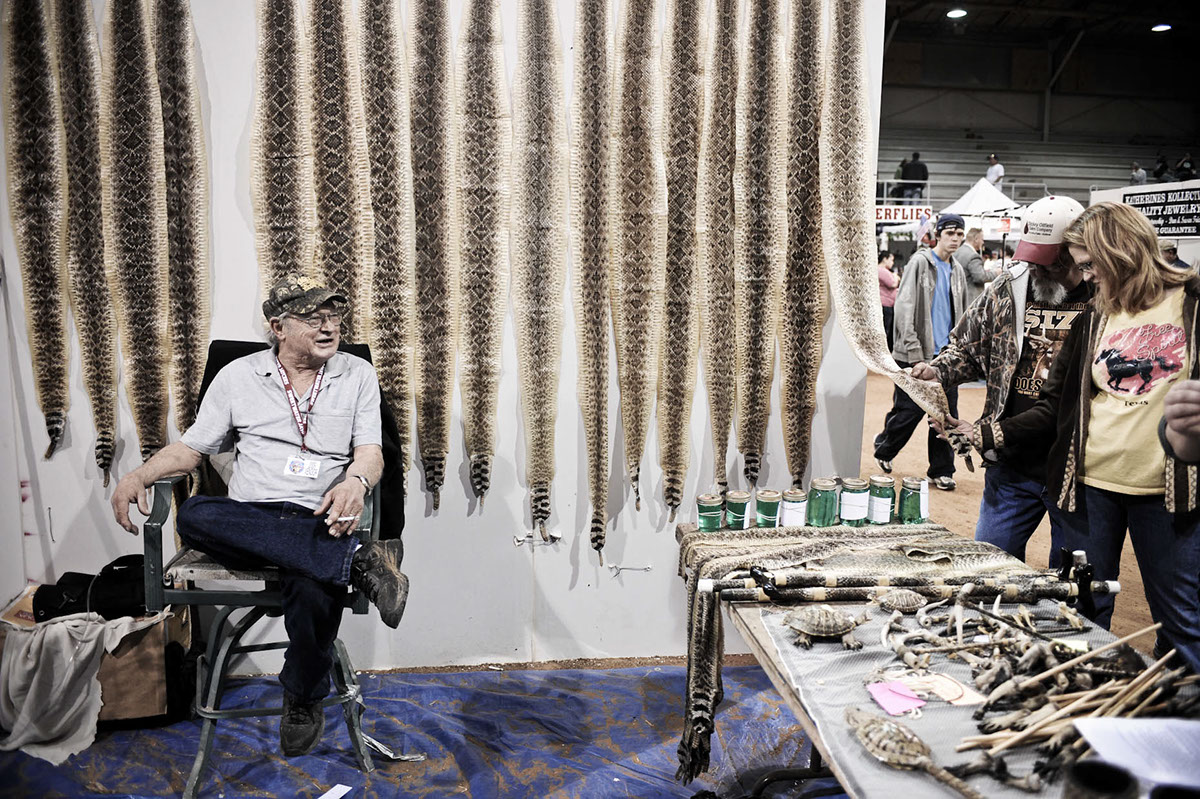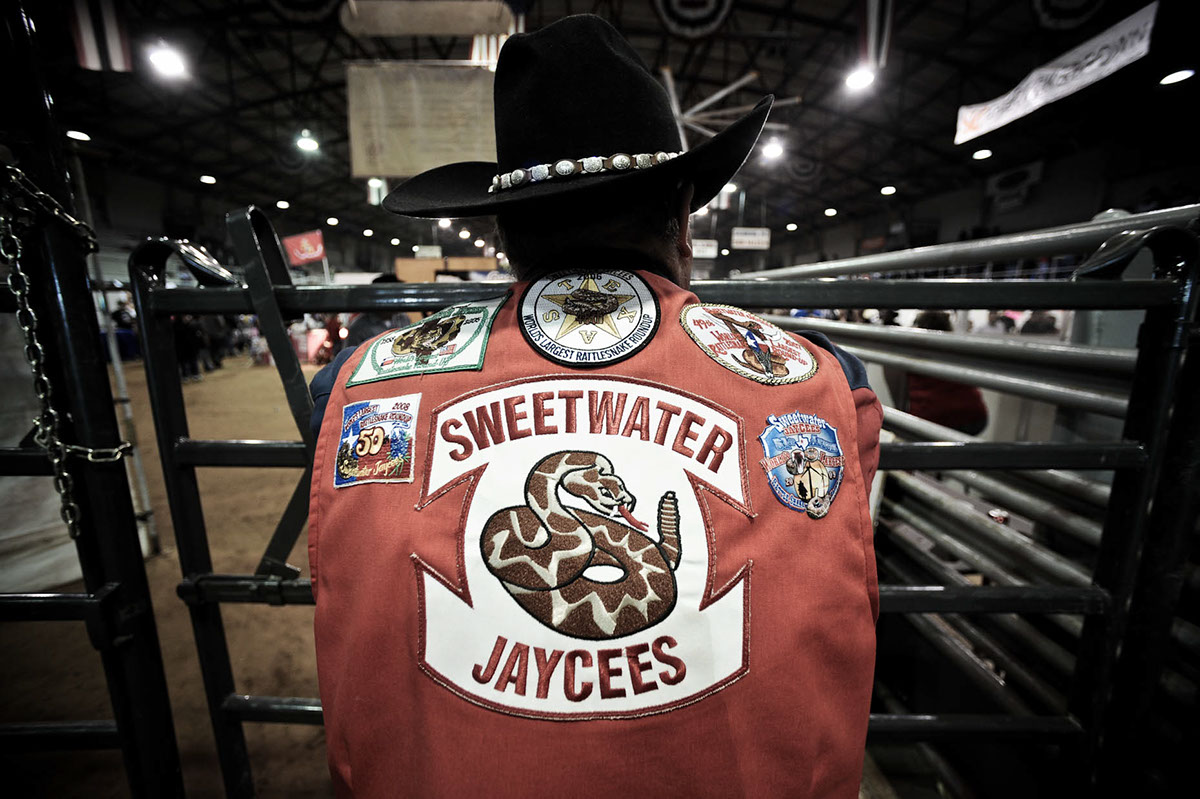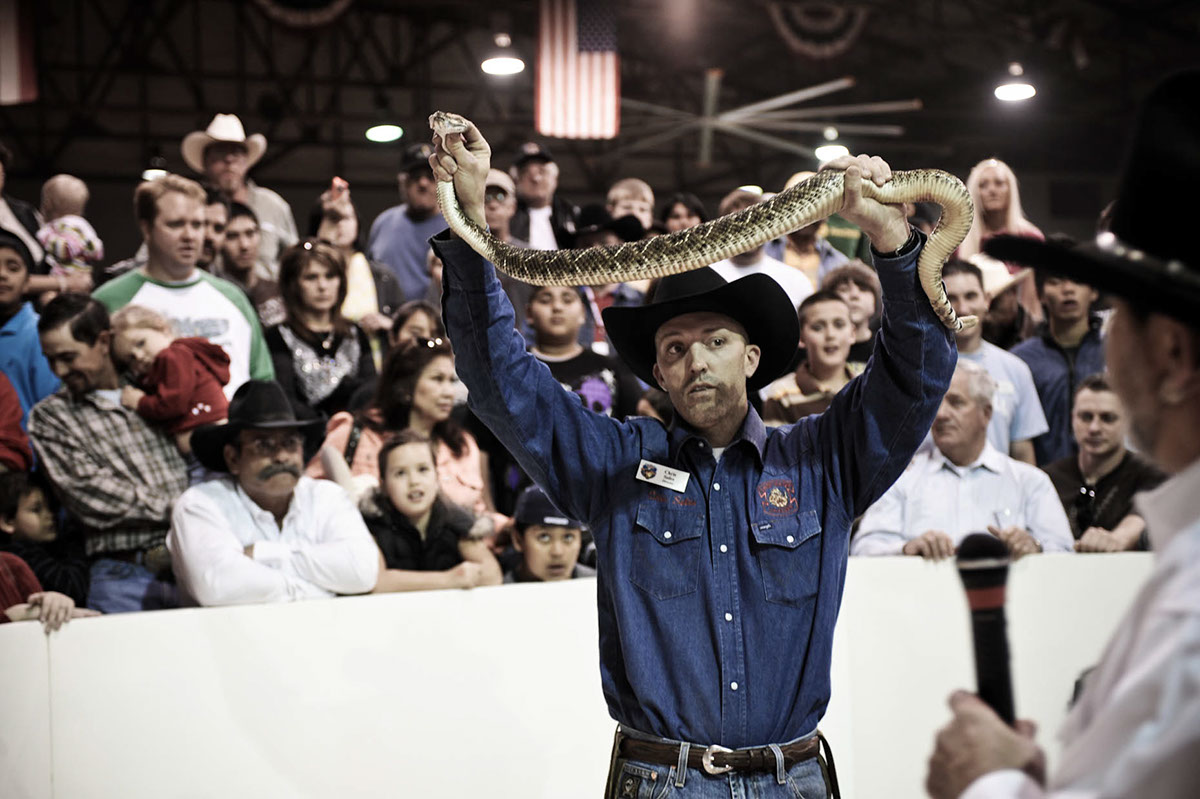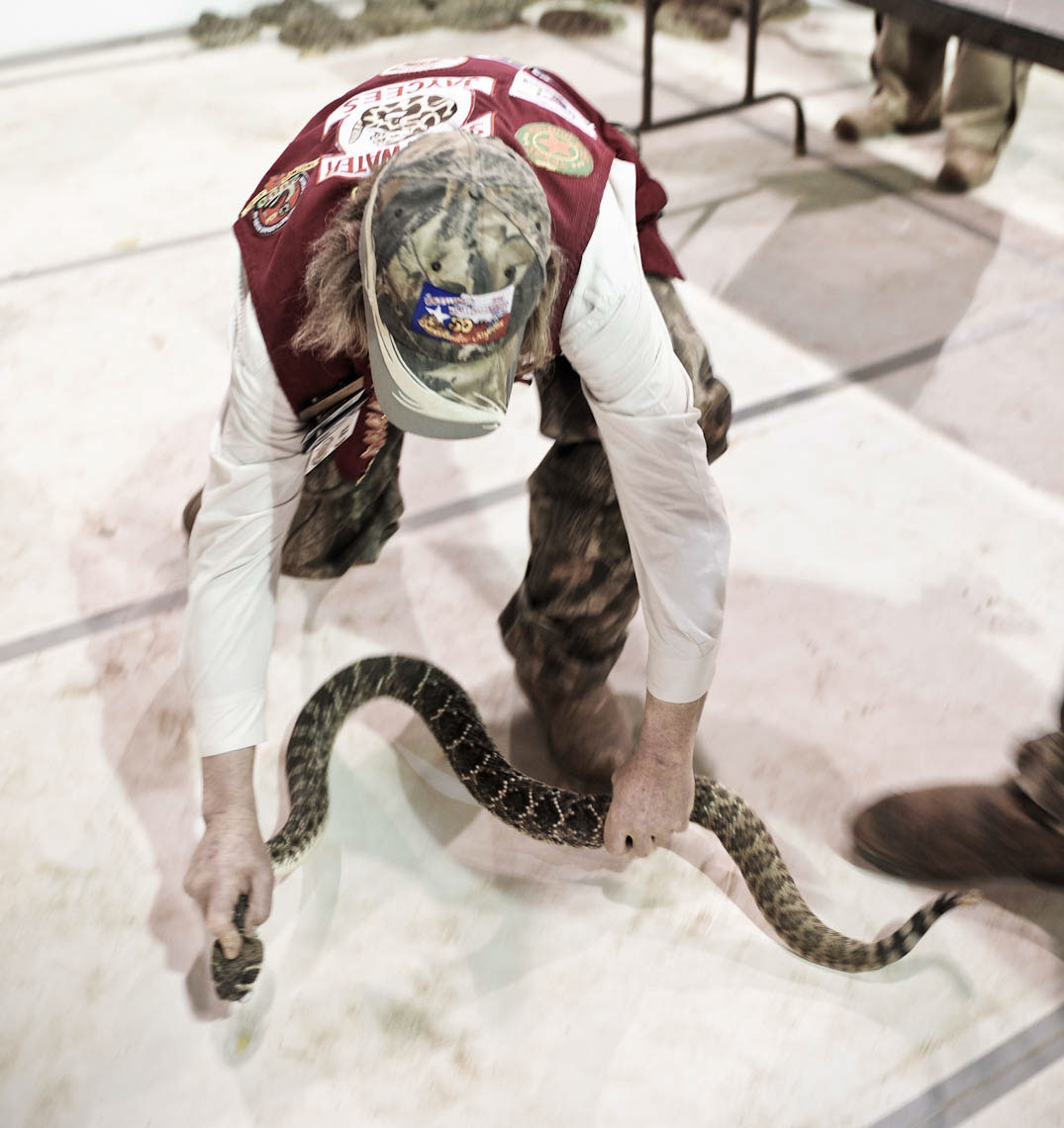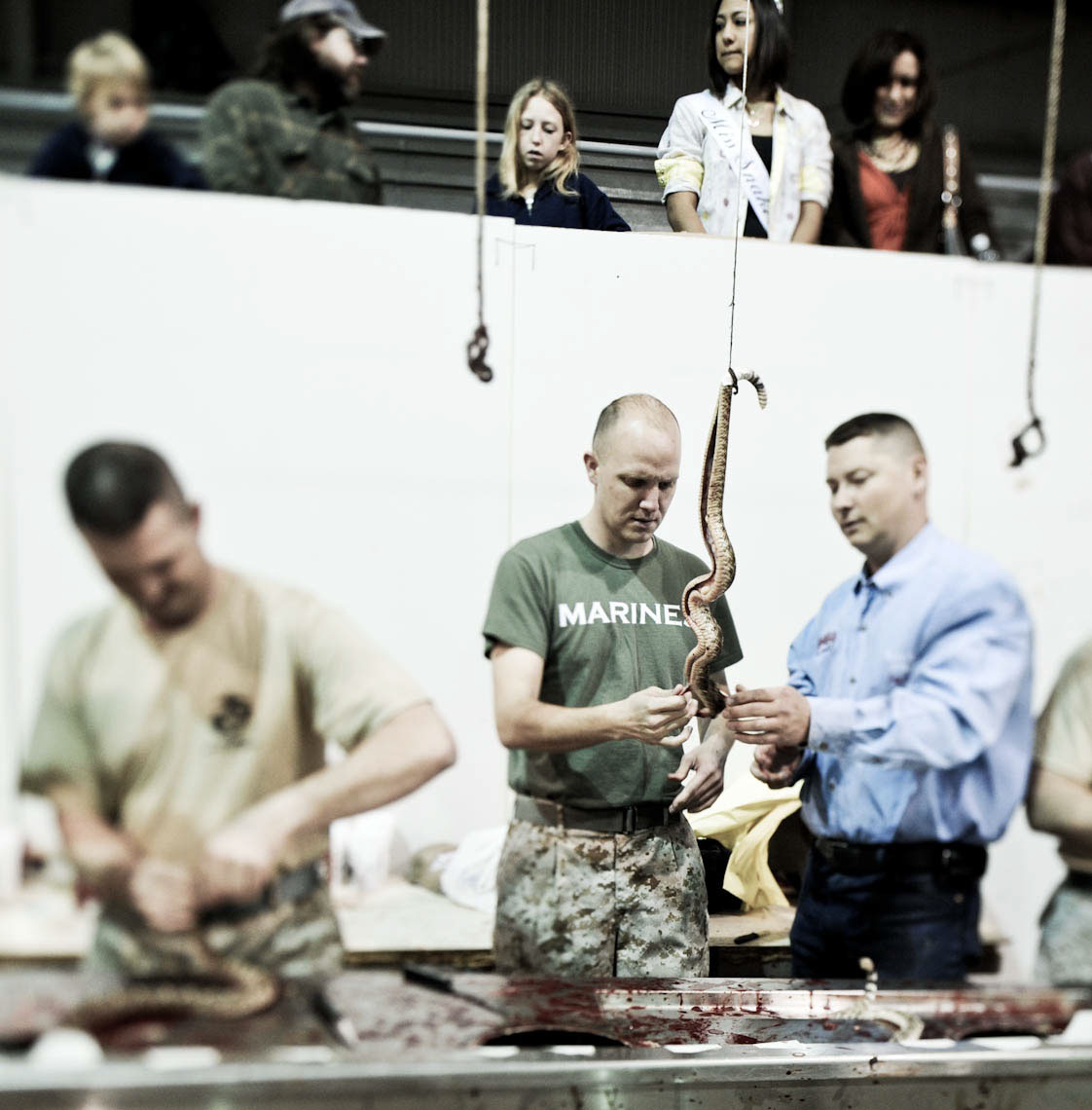
Sweetwater Rattlesnake Roundup
Story and Photos by Kevin Brown
Story and Photos by Kevin Brown
SWEETWATER, TEXAS - The city limit sign along a lonely stretch of two-lane blacktop at the edge of town shows the population in Sweetwater to be 11,415. No word on whether or not that number includes the scaly residents that slither around on their bellies and pile up by the thousands in rocky dens or not, but it’s unlikely. No census taker in their right mind would go door-to-door, or rather den-to-den, to count.
But more than a few folks might argue that not everyone in Sweetwater is in their right mind, unless of course those folks like rattlesnakes.
While “life is sweeter in Sweetwater” for many, for the rattlesnake population March spells trouble. And it has since 1958 when local ranchers and cattlemen decided it was time to join forces and do something to rid the red dirt landscape of the tongue-flicking critters that had plagued their livestock since the area, about 40 miles west of Abilene, was settled.
This past March marked the 51st annual event hosted by the Sweetwater Jaycees that is billed as the “world’s largest rattlesnake round-up.”
And 2009 was a record-breaking year in terms of attendance. Jaycee’s president Kevin Sager estimates the crowd at about 40,000.
And there were a few snakes on hand, too. Officially, 5,199 pounds of rattlesnakes were brought in. That’s more than in 2008, but a little below average.
Each year, teams of rattlesnake hunters scour the countryside prior to the actual round-up event looking for snakes. Hunters, who now must have a license to hunt, use various methods for searching for rattlesnakes, but one of the most common is to use a small handheld mirror to reflect sunlight up under rocks and other hiding areas to spot their prize.
Some hiding spots may just have a snake or two and some dens have hundreds of snakes.
Some hunters pump gasoline fumes into a den and then wait for the snakes to escape the fumes. As the rattlesnakes emerge from the den, hunters pick them up with large tongs or golf clubs modified with a hook on the end. Snakes are put in boxes, barrels or sacks and are ultimately transported to the round-up for weigh-in. Only live snakes are accepted. Hunters are paid $5 per pound up to 2,000 pounds, with the amount decreasing per pound for extra large hauls.
The average snake weighs about three pounds.
As the hunters anticipate the annual round-up, so-to do the non-hunters.
Visitors from across the country - and around the world - flock to Sweetwater for four days each March to soak up the sights much like a diamondback might soak up the sun on a west Texas afternoon.
And there’s a lot to take in including a flea market, a carnival, and a gun, knife, and coin show.
But inside the Nolan County Coliseum lies (er-uh, slithers) the main attraction: rattlesnakes. And specifically, these are western diamondback rattlesnakes.
The infamous creature of many-a-western movie that plays on our fears with the simple rattle of its tail and flick of its tongue is center stage.
And for $7 ($5 for kids) visitors can face those fears and see this rock star of the snake world by the thousands.
On the floor of the coliseum, amid myriad exhibitor booths hocking everything from snake heads in mason jars, to snake head key rings and snake skin belts, are several fenced-off areas where various snake demonstrations take place. These small octaganol arenas each have a four foot high solid wall perimeter where folks can come right up and rest their elbows and peer over to see the rattlers and their handlers. And don’t leave the kids at home. They can see all the action thru plexiglass windows scattered around the perimeter wall.
There’s the rattlesnake milking area where members of the Sweetwater Jaycees carefully milk snakes to collect venom. One by one, each snake is milked by hooking the snake’s fangs over the edge of a glass funnel and applying pressure to the snake’s poison glands. The venom, which slightly resembles an orange sports drink, is released and collected into a bottle. The process only takes a few seconds per snake.
For 2009, 1.75 liters of venom was collected. The venom is sold to a lab where it is used for research and to make antivenin/anitvenom.
Another small arena is dedicated to rattlesnake research. Over the course of the four-day event, hundreds of snakes are measured and weighed. The number of rattles are counted as well as the number of stripes on the “coon tail.” The coon tail is a black and white striped area just above the rattles and is one of the things that distinguishes a western diamondback from other rattlers. A quick test to determine the sex each snake also takes place. The data is recorded and shared with the Texas Department of Parks and Wildlife.
An area not for the squeamish is where snakes are beheaded and skinned. A team of two beheads each snake. One man grabs a snake with a set of tongs about three to four inches behind the head and places it on a stump. With one swift motion, another man chops the head off with a machete.
Snake heads are put in a bucket where they can be seen wiggling and biting for hours. Snake bodies are skinned by a team of rotating volunteers. It should be noted that no part of a snake, except for the organs, is wasted. (A group of Chinese is said to have bought organs in 2008).
Rattlesnake meat sells for about $20 per pound and the heads, skins and rattles are sold and used to create items of all kinds.
But the big buzz in the coliseum is the main arena. And the buzz isn’t just from the excitement of the crowd, it’s from the rattlesnakes that call this area home. It’s also home to David Sager. A thirty-one year veteran of the rattlesnake round-up and a Lifetime member of the Jaycees, Sager conducts several shows per day to bleacher-filled standing-room only crowds of folks itching to get a glimpse of rattlesnakes in action.
As he calmly walks around the arena, stepping inches from rattlesnakes coiled up and ticked off, Sager rattles off diamondback facts to a spellbound crowd. He’ll pick up a snake and let young and old touch its skin and feel its rattles. Occasionally, a snake in the pit will strike at him, but he never flinches, never blinks. He knows the tall boots he wears will protect him from these strikes, but the crowd oohs and ahhs.
Cell phone cameras are at the ready as Sager taunts a rattlesnake with a balloon, much like a bullfighter waves a red cape at an angry bull. In a split-second, the snake strikes, the balloon pops, and the crowd jumps.
Sager, and all of the Jaycees, promote safety at every opportunity. They tell tales of those who have been bitten and have suffered the pain from a rattlesnake bite as well as the pains from the doctor bills that can approach $40,000 or even $50,000.
The four day event starts with a parade and the crowning of Miss Snake Charmer...and it culminates with the awarding of prizes for the biggest individual snake captured as well as the most pounds of snakes brought in by an individual team.
The first place team led by Andy Lee brought in 1,378 pounds of snakes and the big snake for 2009 was 68 inches long and was brought in by veteran hunter Herbert Hoover. Hoover has participated in all 51 rattlesnake roundups. This was his second big snake award.
“Snake hunting is a lot of fun,” he says with a smile.
With an estimated 1,700 snakes brought in for the 2009 round-up, who’s to say what the population of Sweetwater is now.
The sign says 11,415.
But somewhere, deep in the rocky dens outside of town, a few thousand snakes lie patiently waiting.
Waiting on that census taker to come a ‘knockin.
But more than a few folks might argue that not everyone in Sweetwater is in their right mind, unless of course those folks like rattlesnakes.
While “life is sweeter in Sweetwater” for many, for the rattlesnake population March spells trouble. And it has since 1958 when local ranchers and cattlemen decided it was time to join forces and do something to rid the red dirt landscape of the tongue-flicking critters that had plagued their livestock since the area, about 40 miles west of Abilene, was settled.
This past March marked the 51st annual event hosted by the Sweetwater Jaycees that is billed as the “world’s largest rattlesnake round-up.”
And 2009 was a record-breaking year in terms of attendance. Jaycee’s president Kevin Sager estimates the crowd at about 40,000.
And there were a few snakes on hand, too. Officially, 5,199 pounds of rattlesnakes were brought in. That’s more than in 2008, but a little below average.
Each year, teams of rattlesnake hunters scour the countryside prior to the actual round-up event looking for snakes. Hunters, who now must have a license to hunt, use various methods for searching for rattlesnakes, but one of the most common is to use a small handheld mirror to reflect sunlight up under rocks and other hiding areas to spot their prize.
Some hiding spots may just have a snake or two and some dens have hundreds of snakes.
Some hunters pump gasoline fumes into a den and then wait for the snakes to escape the fumes. As the rattlesnakes emerge from the den, hunters pick them up with large tongs or golf clubs modified with a hook on the end. Snakes are put in boxes, barrels or sacks and are ultimately transported to the round-up for weigh-in. Only live snakes are accepted. Hunters are paid $5 per pound up to 2,000 pounds, with the amount decreasing per pound for extra large hauls.
The average snake weighs about three pounds.
As the hunters anticipate the annual round-up, so-to do the non-hunters.
Visitors from across the country - and around the world - flock to Sweetwater for four days each March to soak up the sights much like a diamondback might soak up the sun on a west Texas afternoon.
And there’s a lot to take in including a flea market, a carnival, and a gun, knife, and coin show.
But inside the Nolan County Coliseum lies (er-uh, slithers) the main attraction: rattlesnakes. And specifically, these are western diamondback rattlesnakes.
The infamous creature of many-a-western movie that plays on our fears with the simple rattle of its tail and flick of its tongue is center stage.
And for $7 ($5 for kids) visitors can face those fears and see this rock star of the snake world by the thousands.
On the floor of the coliseum, amid myriad exhibitor booths hocking everything from snake heads in mason jars, to snake head key rings and snake skin belts, are several fenced-off areas where various snake demonstrations take place. These small octaganol arenas each have a four foot high solid wall perimeter where folks can come right up and rest their elbows and peer over to see the rattlers and their handlers. And don’t leave the kids at home. They can see all the action thru plexiglass windows scattered around the perimeter wall.
There’s the rattlesnake milking area where members of the Sweetwater Jaycees carefully milk snakes to collect venom. One by one, each snake is milked by hooking the snake’s fangs over the edge of a glass funnel and applying pressure to the snake’s poison glands. The venom, which slightly resembles an orange sports drink, is released and collected into a bottle. The process only takes a few seconds per snake.
For 2009, 1.75 liters of venom was collected. The venom is sold to a lab where it is used for research and to make antivenin/anitvenom.
Another small arena is dedicated to rattlesnake research. Over the course of the four-day event, hundreds of snakes are measured and weighed. The number of rattles are counted as well as the number of stripes on the “coon tail.” The coon tail is a black and white striped area just above the rattles and is one of the things that distinguishes a western diamondback from other rattlers. A quick test to determine the sex each snake also takes place. The data is recorded and shared with the Texas Department of Parks and Wildlife.
An area not for the squeamish is where snakes are beheaded and skinned. A team of two beheads each snake. One man grabs a snake with a set of tongs about three to four inches behind the head and places it on a stump. With one swift motion, another man chops the head off with a machete.
Snake heads are put in a bucket where they can be seen wiggling and biting for hours. Snake bodies are skinned by a team of rotating volunteers. It should be noted that no part of a snake, except for the organs, is wasted. (A group of Chinese is said to have bought organs in 2008).
Rattlesnake meat sells for about $20 per pound and the heads, skins and rattles are sold and used to create items of all kinds.
But the big buzz in the coliseum is the main arena. And the buzz isn’t just from the excitement of the crowd, it’s from the rattlesnakes that call this area home. It’s also home to David Sager. A thirty-one year veteran of the rattlesnake round-up and a Lifetime member of the Jaycees, Sager conducts several shows per day to bleacher-filled standing-room only crowds of folks itching to get a glimpse of rattlesnakes in action.
As he calmly walks around the arena, stepping inches from rattlesnakes coiled up and ticked off, Sager rattles off diamondback facts to a spellbound crowd. He’ll pick up a snake and let young and old touch its skin and feel its rattles. Occasionally, a snake in the pit will strike at him, but he never flinches, never blinks. He knows the tall boots he wears will protect him from these strikes, but the crowd oohs and ahhs.
Cell phone cameras are at the ready as Sager taunts a rattlesnake with a balloon, much like a bullfighter waves a red cape at an angry bull. In a split-second, the snake strikes, the balloon pops, and the crowd jumps.
Sager, and all of the Jaycees, promote safety at every opportunity. They tell tales of those who have been bitten and have suffered the pain from a rattlesnake bite as well as the pains from the doctor bills that can approach $40,000 or even $50,000.
The four day event starts with a parade and the crowning of Miss Snake Charmer...and it culminates with the awarding of prizes for the biggest individual snake captured as well as the most pounds of snakes brought in by an individual team.
The first place team led by Andy Lee brought in 1,378 pounds of snakes and the big snake for 2009 was 68 inches long and was brought in by veteran hunter Herbert Hoover. Hoover has participated in all 51 rattlesnake roundups. This was his second big snake award.
“Snake hunting is a lot of fun,” he says with a smile.
With an estimated 1,700 snakes brought in for the 2009 round-up, who’s to say what the population of Sweetwater is now.
The sign says 11,415.
But somewhere, deep in the rocky dens outside of town, a few thousand snakes lie patiently waiting.
Waiting on that census taker to come a ‘knockin.








